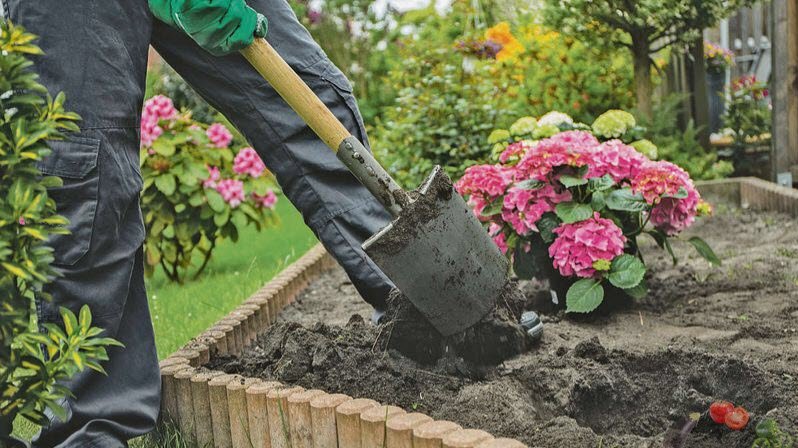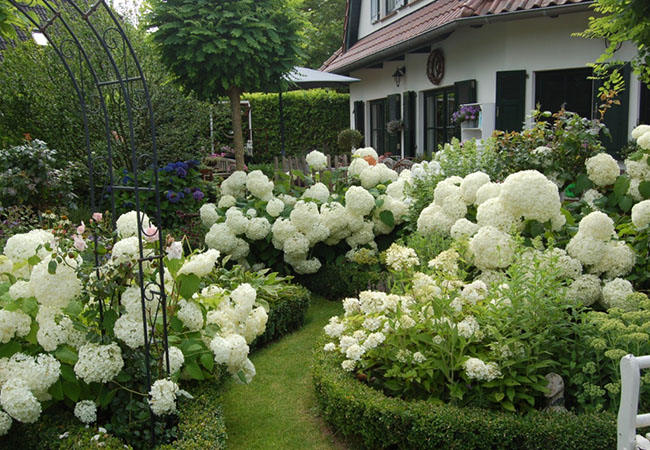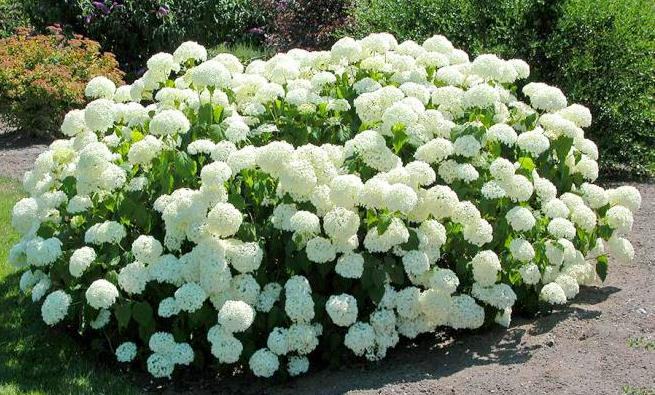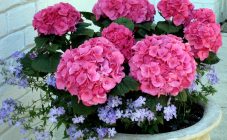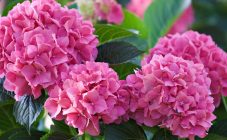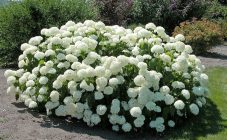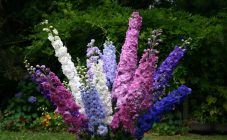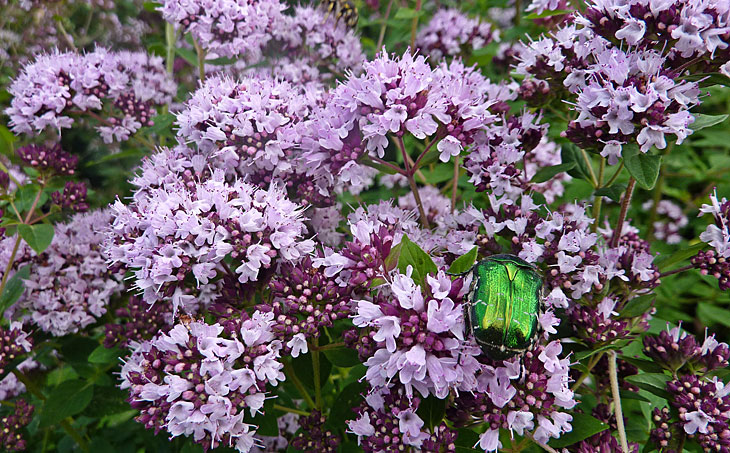Hydrangea is a brightly flowering plant. According to the taxonomy, hydrangea is a representative of the dicotyledonous class, of the order of cornelian flowers, of the hydrangea family. Translated from Latin, hydrangea means "vessel with water."
Hydrangea in the country is popular as an ornamental plant. It can reach a height of 4 meters, it is actively used for decorating parks and gardens, thanks to large bright inflorescences. Hydrangea planting and caring for it does not require much effort. Hydrangea grows quickly enough. Growing a plant begins at home. For 2 years, the seedling will delight at home with the first buds. After this period, the bush should be transplanted into open ground conditions.
It is known that hydrangea is a light-loving plant, and the composition of the soil should contain an abundance of organic matter and have a neutral or slightly acidic pH reaction.
Planting hydrangeas
How to plant a hydrangea? For planting hydrangeas, you should purchase a bush sapling. However, you can also grow a seedling from seeds. This method will take much longer.
How to plant hydrangea seeds? Sowing seeds should be carried out in the autumn. For planting, you must choose a soil rich in organic matter. You can independently prepare a soil mixture from peat, leafy earth and river sand in a ratio of 2: 4: 1. The prepared soil must be carefully loosened. After sowing the seeds, they need to be sprinkled with a thin layer of soil, which should be moistened with a spray bottle.
After planting the hydrangea, the container should be covered with foil or glass, removing it several times a day to ventilate the soil. Maintaining soil moisture is also important.
The ideal temperature range for seed germination is 14-20 ° C. After the emergence of seedlings, the shelter must be completely removed.
The pick is carried out in 2 stages. The first time the seedlings should be dived when the cotyledons appear, the second time - in early spring. During the second pick, choose a small pot size.
After the second transplant, young plants need to start hardening procedures. For this, the pots can be taken out into the fresh air during the summer. Places should be chosen that are protected from direct sunlight, drafts and precipitation. At night, the hydrangeas must be returned to the room.
Growing at home lasts for 2 years. During this period, you can keep the pots outdoors in summer and in cool, well-lit conditions in winter.
At the age of 2 years, the seedlings are ready for transplantation to the main growing site. How to plant a hydrangea outdoors?
It is better to transplant in early spring. A competent choice of the place of growth is the key to good plant growth.
How to grow hydrangea in the garden? Hydrangeas are demanding on lighting conditions, they need to choose places with indirect sunlight. The seedling soil should be chosen, as much as possible, as enriched in organic matter, with a neutral or slightly acidic pH reaction.
Planting hydrangea bushes next to other plants with a shallow root system is undesirable. This neighborhood will lead to the development of competition for nutrients and moisture.
When is the best time to plant hydrangea in fall or spring? Planting in spring will help the seedling grow stronger for winter.
For planting, you must prepare a planting pit. Its size should be 2 times larger than the size of the root system of a young plant, together with an earthen lump adjacent to it. After that, you need to apply complex fertilizers, both organic and mineral. In addition, it is necessary to add a peat mixture mixed with earth.
Remove the seedling from the pot together with the soil. After shaking off and straightening the roots, lower them into the pit and cover them with soil and compost.
Having buried the roots, the soil covering them must be carefully compacted, watered and mulched with needles near the trunk.
Hydrangea care
Hydrangeas in the garden are demanding in terms of watering. They almost always need moist soil. Planting next to Erica and crowberry will constantly maintain a slight acidity of the soil for the hydrangea.
Growing in dense soils imposes the obligation of frequent loosening. The introduction of organic substances stimulates the growth and development of the shrub. To aerate the soil, loosening should be carried out to a depth of 5 cm.
Street hydrangea bushes are characterized by poor drought resistance. In hot conditions, weekly abundant watering is required at the rate of 15-20 liters of water per plant. At normal times, watering 1-2 times a month is sufficient. Mulching the soil with needles, wood chips or bark allows you to maintain soil moisture and maintain acid balance.
As a rule, hydrangea does not have good frost resistance. Although there are varieties that calmly endure the winter season. For the cooling period, it is necessary to use special covering materials to avoid freezing of the bush.
To obtain maximum flowering, it is worth feeding the bush at least 2 times a year. It is worth feeding during the beginning of flowering and after the last flowers have fallen off. In early spring, a urea solution is suitable as a top dressing. It should be cooked according to the scheme 2 grams per 1 liter of water. One plant requires 30 liters of such a solution.
After the end of flowering, minerals must be used as top dressing. In the summer, it is better to use slurry.
Sanitary pruning of shoots is required for bushes older than 3-4 years after planting. Pruning, that is, caring for the shrub, cutting off the flowering stems of the current year, should be at the beginning of the summer season.
The optimal time is when the kidneys swell and begin to look alive. Excessively long stems should be cut at 3-4 buds. In addition, it is imperative to cut off damaged and dried branches.
After the pruning procedure, an excess of various segments remains. They can be used to propagate hydrangeas by cuttings. To do this, there must be at least 2 nodes on each handle. To form a cutting, it is necessary that the cut above the knot is straight, and below the lower one - oblique. For proper cutting, it is necessary to measure 2-3 cm from the node. To plant such a cutting, it is necessary to equip a greenhouse container. Choose a mixture of peat and sand as a soil. The planting of the cuttings occurs at a depth of 3 cm, after which it is necessary to water the soil abundantly.
The ability to flower directly depends on the development of the root system. Therefore, it is necessary to correctly follow the fertilization and irrigation scheme. Overfed plants take an order of magnitude longer to form the root system, which will result in the absence or very poor flowering.
Types of hydrangeas
The variety of bred species allows you to choose a variety that suits the given conditions.
Treelike hydrangea is popular with garden owners. The plant looks like a shrub, 1-3 meters high. Inflorescences form at the tips of annual branches. The flower color is usually light green when opened, and cream or white when fully blooming.
Panicle hydrangea is a tree-like shrub. Its height can vary within 2-5 meters. In favorable conditions, such a plant can exist for over 40 years. Stem lignification occurs in a short time. This quality makes the plant winter hardy. Inflorescences form in the upper sections of young stems. A characteristic feature is the presence of foliage of inflorescences. The flowering period is in August-September. The inflorescences resemble pyramids in shape. The multi-colored change of colors is interesting. At the beginning of flowering, the inflorescences are pale green in color, after full disclosure they turn white. At the end of summer, the flowers become light pink, and after that they turn brick. Towards the end of flowering, the inflorescences turn white again.
Large-leaved hydrangea or garden broadleaf is often used for growing in the garden. Certain varieties can be grown in pots. The leaves of such a hydrangea are rich green, rather dense. The stems that have grown this year are herbaceous, and therefore the bush has practically no frost resistance. Inflorescences are formed on last year's stems, since buds are laid in the autumn. The inflorescences themselves are of the Kal-shaped umbrella shape, otherwise called hemispherical. The color of the inflorescences depends on the pH of the soil: in an acidic environment - blue, in a neutral one - lilac.
Groundcover hydrangea is a winter-hardy species. It reaches a height of 2-3 meters. It is often used to form a standard form. Long green leaves are smooth on the front side, pubescent on the inside. The thyroid-shaped inflorescences are white at the beginning of flowering, then changing the color to pink.
Growing hydrangea in the suburbs
How to grow hydrangea in the suburbs? In the middle zone of the Russian Federation, for example, the Leningrad or Moscow region, planting hydrangeas requires preparation. It is better to place the seedling in a shaded place. Having planted a bush under the scorching sun, it is necessary to shade. Otherwise, in conditions of a lack of moisture, it will not work to get a viable plant.
Creating favorable conditions for wintering will allow you to get rich flowering. Proper feeding will allow the plant to develop a root system. For the first fertilization, you should take urea with a high percentage of nitrogen in the composition. After 2 weeks, you need to feed with a complex organic fertilizer.In the process of bud formation, you can feed the bush with a complex of organic and mineral substances.
Summing up, we can say that hydrangea is rightfully considered an excellent ornamental plant, pleasing the eye with lush and bright flowering. By observing the prescribed care conditions, you can get a strong plant with a lifespan of more than 40 years.
